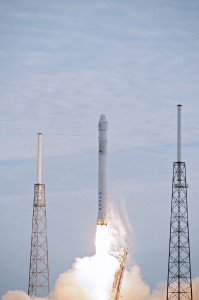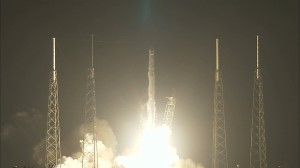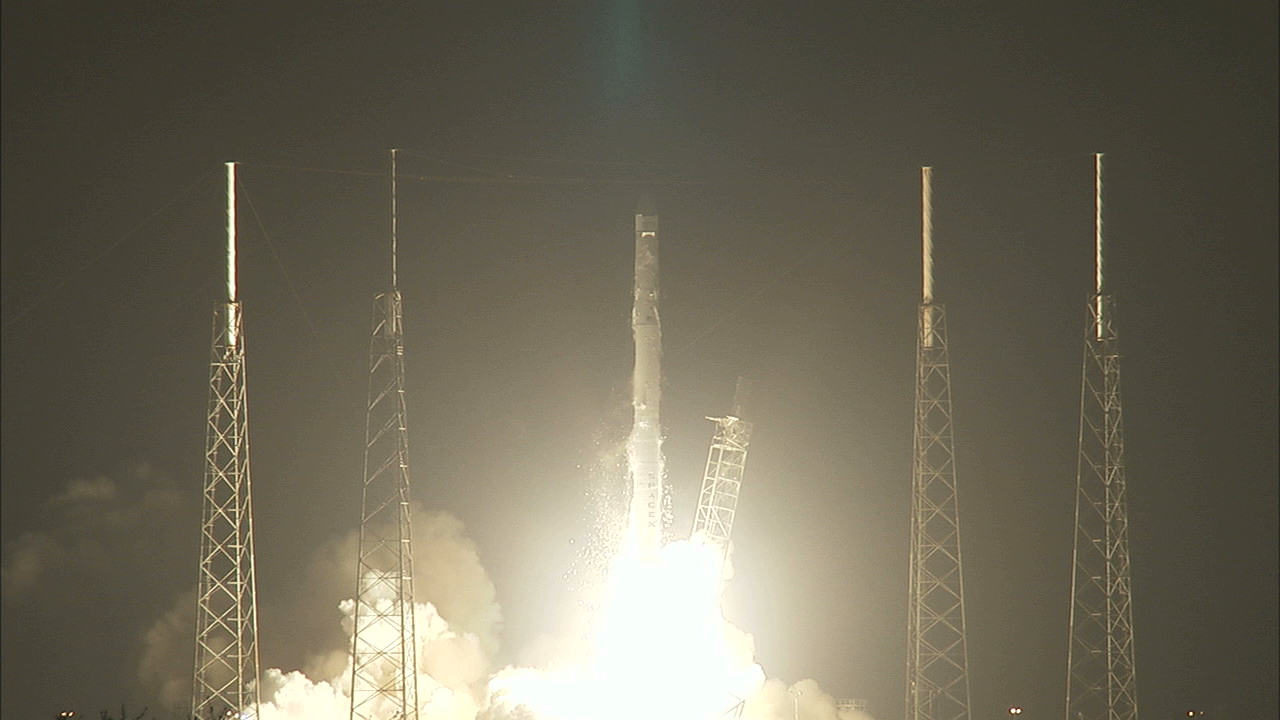Meteorologists predict a 70 percent chance of favorable weather for the planned Dec. 19 launch of the fifth SpaceX cargo mission to the International Space Station. According to the U.S. Air Force’s 45th Weather Squadron, a system developing along the western Gulf Coast tomorrow will bring mid- and upper-level clouds over Florida’s Space Coast. These clouds could linger through Friday, making the possibility of thick clouds the primary concern. In the event of a 24-hour delay, the 70 percent “go” forecast is expected to remain the same for Saturday.
NASA, SpaceX Update Launch of Resupply Mission
The fifth SpaceX cargo mission to the International Space Station under NASA’s Commercial Resupply Services contract now is scheduled to launch no earlier than 1:20 p.m. EST Friday, Dec. 19, from Space Launch Complex 40 at Cape Canaveral Air Force Station in Florida. NASA Television coverage of the launch begins at 12:15 p.m.
The change of launch date allows SpaceX to take extra time to ensure they do everything possible on the ground to prepare for a successful launch. Both the Falcon 9 rocket and its Dragon spacecraft are in good health.
The prelaunch news conferences also have moved to Thursday, Dec. 18 at the agency’s Kennedy Space Center in Florida. All briefings, which are subject to a change in time, will air live on NASA TV and the agency’s website.
The first briefing of the day will air at noon and will provide up-to-date information about the launch. Participants for the prelaunch briefing will be:
- Mike Suffredini, NASA’s ISS Program manager
- Hans Koenigsmann, vice president for Mission Assurance at SpaceX
- Kathy Winters with the U.S. Air Force’s 45th Weather Squadron at Cape Canaveral Air Force Station in Florida
The second briefing, now at 1:30 p.m., will cover some of the numerous science investigations headed to the space station. Participants for the science briefing will be:
- Julie Robinson, NASA’s ISS Program chief scientist
- Michael Roberts, senior research pathway manager at the Center for the Advancement of Science in Space, headquartered in Melbourne, Florida
- Cheryl Nickerson, Micro-5 principal investigator at Arizona State University
- Samuel Durrance, NR-SABOL principal investigator at the Florida Institute of Technology in Melbourne
The final briefing, now at 3 p.m., will cover the Cloud-Aerosol Transport System (CATS) Earth science instrument headed to the space station. Participants for this briefing will be:
- Julie Robinson, ISS Program chief scientist at NASA’s Johnson Space Center in Houston
- Colleen Hartman, deputy director for science at NASA’s Goddard Space Flight Center in Greenbelt, Maryland
- Robert J. Swap, program scientist with the Earth Science Division at NASA Headquarters in Washington
- Matthew McGill, CATS principal investigator at Goddard
An on-time launch on Dec. 19 will result in the Dragon spacecraft arriving at the space station on Sunday, Dec. 21. Expedition 42 Commander Barry “Butch” Wilmore of NASA will use the station’s 57.7-foot robotic arm to reach out and capture it at about 6 a.m. Flight Engineer Samantha Cristoforetti of the European Space Agency will support Wilmore as they operate from the station’s cupola. NASA TV coverage of grapple will begin at 4:30 a.m. Coverage of Dragon’s installation to the Earth-facing port of the Harmony module will begin 9 a.m.
Fifth SpaceX Cargo Resupply Mission to Launch Dec. 16
 NASA and SpaceX announced the next commercial resupply mission to the International Space Station, the fifth for the U.S. company, now is set for 2:31 p.m. EST on Tuesday, Dec. 16, from Launch Complex 40 at Cape Canaveral Air Force Station in Florida. NASA Television coverage will begin at 1:15 p.m.
NASA and SpaceX announced the next commercial resupply mission to the International Space Station, the fifth for the U.S. company, now is set for 2:31 p.m. EST on Tuesday, Dec. 16, from Launch Complex 40 at Cape Canaveral Air Force Station in Florida. NASA Television coverage will begin at 1:15 p.m.
The scheduled Prelaunch, Science and Technology, and Cloud-Aerosol Transport System (CATS) briefings will take place Monday, Dec. 15.
Dragon Splashes Down to Cap Fourth Cargo Mission
 SpaceX’s Dragon cargo craft splashed down in the Pacific Ocean at 3:39 p.m. EDT a few hundred miles west of Baja California, Mexico, marking the end of the company’s fourth contracted cargo resupply mission to the International Space Station.
SpaceX’s Dragon cargo craft splashed down in the Pacific Ocean at 3:39 p.m. EDT a few hundred miles west of Baja California, Mexico, marking the end of the company’s fourth contracted cargo resupply mission to the International Space Station.
The spacecraft is returning 3,276 pounds of NASA cargo and science samples from the International Space Station. A boat will take the Dragon spacecraft to a port near Los Angeles, where some cargo will be removed and returned to NASA within 48 hours. Dragon will be prepared for a return journey to SpaceX’s test facility in McGregor, Texas, for processing.
The mission was the fourth of 12 cargo resupply trips SpaceX will make to the space station through 2016 under NASA’s Commercial Resupply Services contract.
Dragon return set for Saturday
 After delivering almost 5,000 pounds of supplies and experiments to the International Space Station during a month-long stay, the SpaceX Dragon cargo spacecraft is set to leave the orbital laboratory on Saturday, Oct. 25.
After delivering almost 5,000 pounds of supplies and experiments to the International Space Station during a month-long stay, the SpaceX Dragon cargo spacecraft is set to leave the orbital laboratory on Saturday, Oct. 25.
The Dragon spacecraft is scheduled to detach from the Earth-facing side of the station’s Harmony module and unberth through commands sent by robotic ground controllers in mission control at NASA’s Johnson Space Center in Houston operating the Canadarm 2 robotic arm. Mission control will maneuver Dragon into place then turn it over to Expedition 41 robotic arm operators Reid Wiseman and Barry Wilmore of NASA for release, which is scheduled for 9:56 a.m. EDT.
NASA Television will provide live coverage of Dragon’s departure beginning at 9:30 a.m. For NASA TV schedule and video streaming information, visit: https://www.nasa.gov/nasatv.
Space station and SpaceX officials delayed Dragon’s departure four days from the originally scheduled date of Oct. 21 because of high sea states in the splashdown and recovery zone west of Baja California.
Dragon is the only space station resupply spacecraft able to return to Earth intact. It will return about 3,276 pounds of cargo, including science samples from human research, biology and biotechnology studies, physical science investigations and education activities sponsored by NASA and the Center for the Advancement of Science in Space, the nonprofit organization responsible for managing research aboard the U.S. national laboratory portion of the space station.
Dragon will execute three thruster firings to move away from the station to a safe distance for its deorbit burn at 2:43 p.m. The capsule will splash down in the Pacific Ocean around 3:39 p.m. Neither the deorbit burn nor the splashdown will broadcast on NASA TV.
Dragon launched on the SpaceX Falcon 9 rocket from the Cape Canaveral Air Force Station, Florida on Sept. 21 on the company’s fourth commercial resupply mission to the station. It arrived at the station Sept. 23.
For more information about the International Space Station, and its research and crews, visit: https://www.nasa.gov/station.
Launch Begins Busy Month on Station
 This morning’s launch begins a busy month in space for the International Space Station as the orbiting laboratory prepares to welcome the Dragon that is already in orbit, then a new increment crew later this week launching on a Soyuz and an Orbital Sciences Cygnus cargo craft in October, said NASA’s Sam Scimemi, director of the International Space Station. The station crew also will conduct two spacewalks in the coming weeks.
This morning’s launch begins a busy month in space for the International Space Station as the orbiting laboratory prepares to welcome the Dragon that is already in orbit, then a new increment crew later this week launching on a Soyuz and an Orbital Sciences Cygnus cargo craft in October, said NASA’s Sam Scimemi, director of the International Space Station. The station crew also will conduct two spacewalks in the coming weeks.
You can read our launch feature from this morning’s liftoff here.
Launch Replay
Next Stop: International Space Station
 Dragon will spend the next two days chasing the International Space Station during which it will conduct a series of thruster firings to refine its path. Tuesday morning at 7:04 a.m. EDT, the Dragon spacecraft will catch up to the orbiting laboratory, and Expedition 41 Flight Engineer and European Space Agency Astronaut Alexander Gerst will use the station’s 57.7-foot robotic arm to reach out and capture it. NASA astronaut and flight engineer Reid Wiseman will work with Gerst as they operate from the station’s cupola.
Dragon will spend the next two days chasing the International Space Station during which it will conduct a series of thruster firings to refine its path. Tuesday morning at 7:04 a.m. EDT, the Dragon spacecraft will catch up to the orbiting laboratory, and Expedition 41 Flight Engineer and European Space Agency Astronaut Alexander Gerst will use the station’s 57.7-foot robotic arm to reach out and capture it. NASA astronaut and flight engineer Reid Wiseman will work with Gerst as they operate from the station’s cupola.
Solar Arrays Deploy
Dragon’s twin solar arrays are deploying now into a position where they will track the sun to produce electricity for the spacecraft’s onboard batteries.
Dragon Flies on its Own!
The Dragon spacecraft has been delivered to orbit! It will soon extend its twin solar array “wings” to begin recharging its batteries as it makes its way to the International Space Station.
